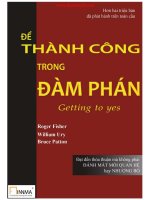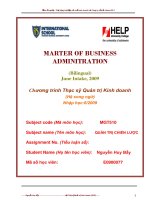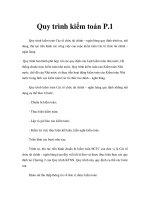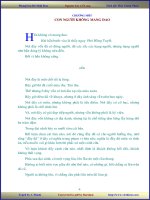The_Alphabet_Soup_Of_Kidney_Transplantat (1).Pdf
Bạn đang xem bản rút gọn của tài liệu. Xem và tải ngay bản đầy đủ của tài liệu tại đây (381.65 KB, 5 trang )
Mini-Review
The Alphabet Soup of Kidney Transplantation: SCD, DCD,
ECD—Fundamentals for the Practicing Nephrologist
Panduranga S. Rao and Akinlolu Ojo
Department of Medicine, University of Michigan, Ann Arbor, Michigan; and the Scientific Registry of Transplant
Recipients, Ann Arbor, Michigan
There is significant variability in the quality of deceased-donor kidneys that are used for transplantation. The quality of the
donor kidney has a direct effect on important clinical outcomes such as acute rejection, delayed graft function, and patient and
allograft survival. Expanded-criteria donors (ECDs) refer to older kidney donors (>60 yr) or donors who are aged 50 to 59 yr
and have two of the following three features: Hypertension, terminal serum creatinine >1.5 mg/dl, or death from cerebrovascular accident. By definition, ECD kidneys have a 70% greater likelihood of failure compared with one from a 35-yr-old
male donor who died from a motor vehicle accident. Donation after cardiac death (DCD) is a small but rapidly growing
fraction of donors. An ECD kidney transplant recipient has a projected average added-life-years of 5.1 yr compared with 10
yr for a kidney recipient from a standard-criteria donor. Kidney transplantation from DCD seems to have similar allograft and
patient survival compared with kidney from donation after brain death; however DCD transplantation has a 42 to 51% risk
for delayed graft function (need for at least one dialysis treatment during the first week after transplantation) compared with
24% in an standard-criteria donor kidney transplant. Familiarity with the comprehensive allocation rules governing different
categories of deceased-donor kidneys by the nephrologists and dialysis team providers is essential to maximizing patient
autonomy and to improve the outcomes of kidney transplantation.
Clin J Am Soc Nephrol 4: 1827–1831, 2009. doi: 10.2215/CJN.02270409
T
ransplantation with organs from deceased donors
(DDs) account for ⬎50% of kidney transplantation in
the United States. More than 90% of patients who had
ESRD and underwent DD kidney transplantation would have
experienced prolonged duration (average of 3 to 5 yr) of maintenance dialysis therapy before receiving a kidney transplant
(1). During this pretransplantation dialysis spell, patients develop a strong relationship with their providing nephrologist
and dialysis team members. Through this patient–provider relationship, the nephrologist gains a comprehensive picture of
the patient’s medical condition and is knowledgeable about the
evolution of comorbidities, health-related quality of life, functional status, beliefs, and value systems. This relationship is
crucial to making major therapeutic decisions, including the
acceptance of a DD organ for transplantation; however, the
providing nephrologist is typically absent from the organ allocation and offer acceptance process, and the patient with ESRD
is provided circumscribed information laden with medical jargon about the quality of the DD organ under offer. In the
rapid-fire tempo of activities surrounding the identification and
matching of an organ to a recipient (computerized match run)
and in the excitement of the moment (after seemingly interminable waiting on the kidney transplant waiting list), most potential recipients accept any organ under offer. Commonly, the
Published online ahead of print. Publication date available at www.cjasn.org.
Correspondence: Dr. Akinlolu O. Ojo, Division of Nephrology, University of
Michigan Health System, 3914 Taubman Center, SPC 5364, Ann Arbor, MI 481095364. Phone: 734-763-9041; Fax: 734-936-9621; E-mail:
Copyright © 2009 by the American Society of Nephrology
transplant team member who makes the organ offer does not
have a long-standing relationship with the dialysis patient, and
the patient-specific information that could be integrated into
making a suitable match between patient and organ is not used.
The absence of the dialysis care provider in the DD organ offer
and acceptance process did not present a significant problem
through the 1980s, when nearly all transplanted kidneys were
from “pristine donors.” The current enduring critical shortage
of organs and the substantial replacement of a virtually stagnant DD pool with decedents whose kidneys have been battered by systemic atherosclerosis means that the pool of donor
kidneys under offer have wide-ranging functional vitality and
pathologic features (2– 4). The evolution in the DD pool has
resulted in a veritable alphabet soup that is used to characterize
donors either to reflect the quality of the donor organ or to
describe the mechanism of death, both of which could presumably have implications for the short- and long-term vitality of
the transplanted organs (5–7). This review describes the terminology used to describe donor kidneys and the kidney transplant clinical outcomes that are associated with the various
categories of donor organs. The review may serve as a primer
for nephrologists and dialysis team members who care for
patients who have ESRD and are potential transplant candidates. Because of the far-reaching implications inherent to the
quality of a transplanted organ, the nephrologist and dialysis
team members are best positioned (on the basis of their previous knowledge and their relationship with the potential recipients) to assist the transplant candidate in making organ acceptance decisions. The nephrologists and dialysis team members
ISSN: 1555-9041/411–1827
1828
Clinical Journal of the American Society of Nephrology
Clin J Am Soc Nephrol 4: 1827–1831, 2009
should be integrated into the process of organ offer and acceptance to buttress patient autonomy and to ensure that the
matching of transplant candidates to transplantable organ is
optimized.
Classification of DDs
The first codified classification of DD kidneys was implemented in October 2002 (8,9). Under this scheme, DD kidneys
were classified into two groups: Standard-criteria donor (SCD)
and expanded-criteria donor (ECD). This classification was
meant to reflect the quality of the organ, and the definition was
driven empirically by the risk for graft loss. An ECD kidney has
a 70% greater risk for failure compared with an SCD kidney (8).
A parallel classification deals with the sequence and mechanisms of cessation of circulatory and respiratory functions (10).
The Organ Procurement and Transplantation Network (OPTN)
is charged with developing policies and procedures for DD
organ procurement, allocation, and distribution in the United
States (11). Figures 1 and 2 show the relationship between the
two classifications systems. The definitions and corresponding
acronyms are provided next.
Standard-Criteria Donor
The classic SCD is a 35-yr-old man who has no history of
hypertension or diabetes and for whom the cause of death is a
motor vehicle accident. In practice, all DDs who do not meet
any of the criteria for an ECD and from whom donation occurred after brain death (donation after brain death [DBD]; see
the Donation after Brain Death section) are considered as an
SCD.
Expanded-Criteria Donor
An ECD is one who, at the time of death, is aged ⱖ60 or aged
50 to 59 yr and has any two the following three criteria: (1)
Cause of death is cerebrovascular accident; (2) preexisting history of systemic hypertension; and (3) terminal serum creatinine ⬎1.5 mg/dl. The criteria for the definition of ECD was
Figure 1. Categories of deceased kidney donors.
Figure 2. Categories within the deceased kidney donor pool:
SCD, ECD, and DCD.
based on the presence of variables that increased the risk for
graft failure by 70% (relative hazard ratio 1.70) compared with
an SCD kidney.
Donation after Brain Death
DBD describe a donor who had primary brain death in
whom cardiac circulation and respiration remain intact or are
maintained by medical measures, including mechanical ventilation, drugs, intra-aortic balloon pump, or extracorporeal machine oxygenation device. A DBD could be an ECD or SCD
depending on whether the ECD/SCD criteria are separately
fulfilled.
Donation after Cardiac Death
The donation after cardiac death (DCD) donor refers to the
donor who does not meet the criteria for brain death but in
whom cardiac standstill or cessation of cardiac function occurred before the organs were procured. The cessation of cardiac function could have occurred spontaneously or been initiated deliberately. The DCD donor was previously referred to
as non– heart-beating donor. The DCD categories encompass
four subgroups, depending on the circumstances and manner
in which cardiac standstill occurred (Maastricht classification),
but only two subtypes of DCD are in common usage (controlled
DCD and uncontrolled DCD), which are defined next (12).
Controlled DCD. The OPTN defines a controlled DCD
(cDCD) as “a donor whose life support will be withdrawn and
whose family has given written consent for organ donation in
the controlled environment of the operating room.” The cDCD
describes a situation in which the donor’s hemodynamic stability and respiratory function were maintained until the decedent is extubated in a controlled environment of the operating
room or in the intensive care unit.
Uncontrolled DCD. The OPTN defines uncontrolled DCD
(uDCD) as “a candidate who expires in the emergency room or
elsewhere in the hospital before consent for organ donation is
obtained and catheters are placed in the femoral vessels and
peritoneum to cool organs until consent can be obtained. Also,
an uncontrolled Donation after Cardiac Death donor is a candidate who is consented for organ donation but suffers a cardiac arrest requiring CPR during procurement of the organs.”
Clin J Am Soc Nephrol 4: 1827–1831, 2009
Classification of Donor Kidneys
1829
Clinical Outcomes of Kidney Transplant
with Different Categories of DDs
Inherent to the definition of an ECD kidney is a 70% increased risk for graft failure compared with an SCD kidney (8).
Nonetheless, diminished allograft survival does not suggest
lack of therapeutic benefits. Although most studies of ECD
kidney transplantation confirm lower allograft survival rates,
recipients of ECD kidneys generally have improved survival
compared with matched dialysis-treated patients (13–15). The
improved recipient survival (relative to the dialysis-treated
patient) is not uniform for all patient groups. On the basis of
data from the US Scientific Registry of Transplant Recipients
(SRTR), Merion et al. (16) found that that long-term mortality
among ECD kidney transplant recipients was 17% lower compared with recipients who did not accept an ECD kidney offer.
The survival benefit was apparent only at 3.5 yr after transplantation and was further confined to recipients who were
older than 40 yr, were non-Hispanic, did not have diabetes, and
were awaiting kidney transplantation in an Organ Procurement
Organization service area in which the average waiting time for
a kidney was ⬎1350 d (⬎45 calendar months). Also using US
national transplant data (SRTR), Miles et al. (14) found that
repeat kidney transplant candidates who received an SCD kidney had better survival than comparable dialysis-treated patients but had no advantage in survival had they received an
ECD kidney for the retransplantation. A useful statistic that can
be given to transplant candidates is that the projected average
added-life-years after an SCD kidney transplantation is 10 yr
compared with 5.1 yr for an ECD kidney transplantation
(17,18). ECD kidney transplantation is associated with a significantly increased risk for delayed graft function (need for dialysis treatment during the first week after transplantation)
(17,19,20).
For the DCD kidney, the appropriate comparison is not with
ECD but with DBD (see Figure 1). Analysis of clinical outcomes
from the US national data by Gagandeep et al. (19) showed that
both the allograft and the recipient survival are similar between
DCD and DBD (Table 1, Figure 3), but the risk for delayed graft
function was 42 to 51% in DCD compared with 24% in DBD
kidney transplant recipients. Similarly, Doshi and Hunsicker
(13) found no significant difference in the 5-yr patient (DCD
versus DBD 81.3 versus 81.8%; P ⫽ 0.70) and allograft survival
Figure 3. Patient and allograft survival of kidney transplantation with DCD donation and DBD organs. Reprinted from
Gagandeep et al. Am J Transplant 6: 1682–1688, 2006 (reference
19), with permission.
(DCD versus DBD 66.9 versus 66.5%; P ⫽ 0.52) when comparing
DCD with DBD kidney transplantation, but there was a significantly higher risk for delayed graft function with DCD kidney
transplantation (DCD versus DBD 41 versus 24%; P ⬍ 0.001).
There seems to be no difference in the risk for acute rejection
episodes between DBD and DCD kidney transplantation (21).
Outcomes of DCD-ECD kidneys, however, are generally poor.
Allocation Process for ECD and DCD
Kidneys
ECD kidneys are allocated to patients on the kidney transplant waiting list in accordance with the allocation policy
(United Network for Organ Sharing Policy 3.5 Allocation of
Cadaveric Kidneys) put in place by the OPTN in October 2002,
which states, “Kidneys procured from the ECD will be allocated to patients determined to be suitable candidates: First, for
zero antigen mismatched patients among this group of patients
with time limitations; and next, for all other eligible patients
locally, regionally, and nationally, based on time waiting and
not the HLA matching” (21). There are several common misconceptions about the ECD allocations policy. First, opting to
receive an ECD kidney does not put the transplant candidate on
Table 1. Clinical outcomes of kidney transplantation performed with the different categories of DD organ
(13,19,23,24)
Clinical Outcome Variable
Acute rejection episode
Delayed graft function
1-yr graft survival
5-yr graft survival
1-yr patient survival
5-yr patient survival
a
SCD (%)
ECD (%)
DBD (%)
DCD (%)
14a
21
90
65
95
82
15a
11
82
49
91
70
37b
24
91
67
95
82
38b
41
89
67
95
81
Acute rejection episode rate at 1 yr after transplantation based on data from Stratta et al. (24).
Acute rejection rate at 2 yr after transplantation based on data from Schadde et al. (23).
b
1830
Clinical Journal of the American Society of Nephrology
a separate waiting list, as is commonly misconstrued. There is
no separate waiting list for ECD kidneys. When a patient expresses an interest in an ECD kidney, this willingness is recorded as an option so that when an ECD kidney becomes
available, only patients who have expressed a recorded interest
will be considered and included in the “match run.” The match
run is a computerized nationwide algorithm that is driven by
specified allocation rules and is used to allocate all DD organs.
The allocation rules or algorithm is not affected by the ECD
option. Whether a patient opts for an ECD does not affect his or
her status or probability of receiving an SCD kidney. The ECD
option is open to all waiting list registrants. Second, a patient
on the waiting list may change his or her desire to be considered for an ECD kidney at any time and may choose not to
accept one particular ECD kidney when offered without jeopardizing his or her status on the waiting list or the chances of
being offered another ECD kidney. Third, an ECD kidney is
awarded only on the basis of the numbers of points accrued as
a result of the time that the candidate has spent on the waiting
list or since initiation of dialysis when applicable. This means
that allocation points accrued for HLA DR match, panel-reactive antibody levels, and other factors in the SCD allocation
process do not count toward the ranking for an ECD kidney
offer. Although several allocation policies deal with DCD, these
policies do not have a direct implication on the candidate’s
decision to accept a DCD kidney. The option of accepting a
DCD kidney is not recorded at the time of waiting list registration, and such kidneys are not reserved for any particular
group of candidates. Providers generally discuss the DCD status with the transplant candidates at the time the offer is made.
Figure 4 shows the graft survival rates for different types of
kidney transplantation.
Living-Donor Kidney Transplantation
The shortage of organs has led to a more expansive use of live
donors in kidney transplantation beyond biologic relatives and
spouses. Individuals can now donate a kidney to an anonymous recipient, and transplant candidates can exchange their
live kidney donor with another candidate when there is biologic incompatibility between the donor candidate and the
Figure 4. Unadjusted 1-, 3-, and 5-yr kidney graft survival, by
donor type: 2000 –2005.
Clin J Am Soc Nephrol 4: 1827–1831, 2009
originally intended recipients. The different categories of live
kidney donors that are commonly recognized today are described next.
Related Donor. The donor and the recipient have a biologic relationship (e.g., siblings and parents).
Unrelated Donor. The live kidney donor is not biologically
related to the donor, although an enduring emotional relationship exists between the donor and the recipient. Donation
between casual acquaintances is now included in this category
(e.g., school mate, co-workers, religious congregants).
Directed Anonymous Donor. The live kidney donor has
no previous relationship with the recipient. A donor who learns
of someone in need of a kidney transplant through the web,
television, or other forum and then volunteers to donate a
kidney would be considered as an anonymous donor who is
directing the donation to a particular person.
Undirected Anonymous Donor. An undirected anonymous donor is a live donor who offers to donate a kidney to the
waiting list. The kidney is transplanted into the person who is
at the top of the list and who would have received the next
appropriate DD kidney. This form of donation has the effect of
shortening the waiting time for everybody on the list by one
donor organ.
Paired Exchange Donor. A pair of donor–recipient candidates (from the related or unrelated categories) enters into a
scheme in which the donor is exchanged with another donor–
recipient candidate pair so as to achieve donor–recipient biologic compatibility of the ABO blood group system and/or
negative cross-match reactivity.
Multiple Paired Exchanged Donor. This is paired exchange donation as described in the preceding section and
involves more than two donor–recipient candidate pairs. Multiple paired exchanges involving paired exchange registries in
different states has been recently described (22).
Conclusions
The range of organ donors for kidney transplantation has
expanded rapidly. There are now several categories of donors
with varied and wide-ranging implications for the clinical outcomes of kidney transplantation. Potential kidney transplant
recipients and their providers need to be well informed about
the choices of available DDs and living donors. Both allograft
and recipient survivals are shortened when ECD kidneys are
used for transplantation. Even though ECD kidney transplantation is superior to dialysis therapy, the inferior outcomes
relative to SCD kidneys should be weighed when patients
consider accepting ECD organs. Survival with a DCD kidney
seems to be similar to DBD kidneys, but the excess risk of
delayed graft function and its consequences need to be appreciated by the patient and other decision makers. Nephrologists
and dialysis team providers are central to the long-term care of
kidney transplant candidates and should be fully engaged in
the process by which their patients are offered DD kidneys.
Disclosures
None.
Clin J Am Soc Nephrol 4: 1827–1831, 2009
Classification of Donor Kidneys
References
1. US Organ Procurement and Transplantation Network/
Scientific Registry of Transplant Recipients: 2007 Annual
Report of the US Organ Procurement and Transplantation Network and the Scientific Registry of Transplant Recipients:
Transplant Data 1997–2006. Rockville, MD, Department of
Health and Human Services, Health Resources and Services Administration, Healthcare Systems Bureau, Division of Transplantation; Richmond, VA, United Network
for Organ Sharing; Ann Arbor, MI, Arbor Research Collaborative for Health, 2008
2. Smith RB, Fairchild R, Bradley JW, Cho SI: Cadaver kidney
donors with hypertensive histories. Transplant Proc 20:
741–742, 1988
3. Alexander JW, Vaughn WK, Carey MA: The use of marginal donors for organ transplantation: The older and
younger donors. Transplant Proc 23: 905–909, 1991
4. Alexander JW, Zola JC: Expanding the donor pool: Use of
marginal donors for solid organ transplantation. Clin
Transplant 10: 1–19, 1996
5. Cho YW: Expanded criteria donors. Clin Transpl 421– 436,
1998
6. Hesse UJ, Vermassen F, Lameire N, Vanholder R: Expanded criteria donors and dual kidney transplantation.
Transpl Int 11: 457– 458, 1998
7. Lee CM, Scandling JD, Shen GK, Salvatierra O, Dafoe DC,
Alfrey EJ: The kidneys that nobody wanted: Support for
the utilization of expanded criteria donors. Transplantation
62: 1832–1841, 1996
8. Metzger RA, Delmonico FL, Feng S, Port FK, Wynn JJ,
Merion RM: Expanded criteria donors for kidney transplantation. Am J Transplant 3[Suppl 4]: 114 –125, 2003
9. Sung RS, Guidinger MK, Lake CD, McBride MA, Greenstein SM, Delmonico FL, Port FK, Merion RM, Leichtman
AB: Impact of the expanded criteria donor allocation system on the use of expanded criteria donor kidneys. Transplantation 79: 1257–1261, 2005
10. Bernat JL, D’Alessandro AM, Port FK, Bleck TP, Heard SO,
Medina J, Rosenbaum SH, Devita MA, Gaston RS, Merion
RM, Barr ML, Marks WH, Nathan H, O’connor K, Rudow
DL, Leichtman AB, Schwab P, Ascher NL, Metzger RA, Mc
Bride V, Graham W, Wagner D, Warren J, Delmonico FL:
Report of a National Conference on Donation after cardiac
death. Am J Transplant 6: 281–291, 2006
11. Organ Procurement and Transplantation Network. Health
Resources and Services Administration, HHS. Final rule.
Fed Regist 64: 56650 –56661, 1999
12. Kootstra G, van Heurn E: Non-heartbeating donation of
kidneys for transplantation. Nat Clin Pract Nephrol 3: 154 –
163, 2007
13. Doshi MD, Hunsicker LG: Short- and long-term outcomes
14.
15.
16.
17.
18.
19.
20.
21.
22.
23.
24.
1831
with the use of kidneys and livers donated after cardiac
death. Am J Transplant 7: 122–129, 2007
Miles CD, Schaubel DE, Jia X, Ojo AO, Port FK, Rao PS:
Mortality experience in recipients undergoing repeat transplantation with expanded criteria donor and non-ECD deceased-donor kidneys. Am J Transplant 7: 1140 –1147, 2007
Ojo AO, Hanson JA, Meier-Kriesche H, Okechukwu CN,
Wolfe RA, Leichtman AB, Agodoa LY, Kaplan B, Port FK:
Survival in recipients of marginal cadaveric donor kidneys
compared with other recipients and wait-listed transplant
candidates. J Am Soc Nephrol 12: 589 –597, 2001
Merion RM, Ashby VB, Wolfe RA, Distant DA, HulbertShearon TE, Metzger RA, Ojo AO, Port FK: Deceaseddonor characteristics and the survival benefit of kidney
transplantation. JAMA 294: 2726 –2733, 2005
Pascual J, Zamora J, Pirsch JD: A systematic review of
kidney transplantation from expanded criteria donors.
Am J Kidney Dis 52: 553–586, 2008
Ratner LE, Kraus E, Magnuson T, Bender JS: Transplantation of kidneys from expanded criteria donors. Surgery 119:
372–377, 1996
Gagandeep S, Matsuoka L, Mateo R, Cho YW, Genyk Y,
Sher L, Cicciarelli J, Aswad S, Jabbour N, Selby R: Expanding the donor kidney pool: Utility of renal allografts procured in a setting of uncontrolled cardiac death. Am J
Transplant 6: 1682–1688, 2006
Whiting JF: Clinical and economic outcomes of the use of
expanded criteria donors in renal transplantation. Semin
Dial 13: 316 –319, 2000
Rosengard BR, Feng S, Alfrey EJ, Zaroff JG, Emond JC,
Henry ML, Garrity ER, Roberts JP, Wynn JJ, Metzger RA,
Freeman RB, Port FK, Merion RM, Love RB, Busuttil RW,
Delmonico FL: Report of the Crystal City meeting to maximize the use of organs recovered from the cadaver donor.
Am J Transplant 2: 701–711, 2002
Rees MA, Kopke JE, Pelletier RP, Segev DL, Rutter ME,
Fabrega AJ, Rogers J, Pankewycz OG, Hiller J, Roth AE,
Sandholm T, Unver MU, Montgomery RA: A nonsimultaneous, extended, altruistic-donor chain. N Engl J Med 360:
1096 –1101, 2009
Schadde E, D’Alessandro AM, Knechtle SJ, Odorico J,
Becker Y, Pirsch J, Sollinger H, Fernandez LA: Alemtuzumab induction and triple maintenance immunotherapy
in kidney transplantation from donors after cardiac death.
Transpl Int 21: 625– 636, 2008
Stratta RJ, Rohr MS, Sundberg AK, Armstrong G, Hairston
G, Hartmann E, Farney AC, Roskopf J, Iskandar SS, Adams
PL: Increased kidney transplantation utilizing expanded
criteria deceased organ donors with results comparable to
standard criteria donor transplant. Ann Surg 239: 688 – 695,
discussion 695– 687, 2004








